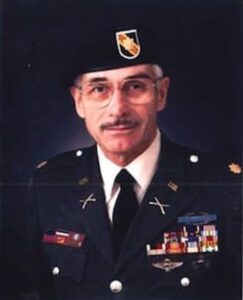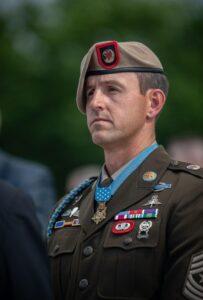USA TODAY, Tom Vanden Brook and David Jackson, 7/27/2018
WASHINGTON – President Donald Trump will award the Medal of Honor to Technical Sgt. John Chapman who was killed in action in 2002 in Afghanistan and whose heroism saved the lives of several of his fellow troops in a battle with al-Qaeda terrorists on a snowy mountaintop.
Trump is scheduled to present the award to Chapman’s spouse, Valerie Nessel, and his family at a White House Ceremony on Aug. 22. The medal, the nation’s highest award for bravery, will be the first presented to a member of the Air Force since the Vietnam War.
Chapman, an Air Force commando, had received the second-highest honor for an airman, the Air Force Cross, for his actions in the battle of Roberts Ridge in March 2002. In 2014, then-Defense Secretary Chuck Hagel ordered review of citations for valor since the Sept. 11 terror attacks. That examination resulted in the upgrade of several medals, including the Medal of Honor to Navy SEAL Britt Slabinski for his heroism in the battle.
In the early hours of March 4, Chapman’s helicopter was hit by a rocket-propelled grenade on Takur Ghar mountain in Afghanistan. The aircraft crashed after one of the troops had been ejected, and Chapman and a joint special operations team returned to rescue him.
After landing, Chapman charged into enemy fire, seized a bunker, and killed the fighters there, according to an account released by the White House. He then burst from cover to quell a machine gun firing on his team from a second bunker. He suffered severe wounds in the second attack.
His fellow special operators believed he was dead and retreated without him. However, analysis of video from a drone years later showed that Champman had continued to fight, a revelation first reported by The New York Times. Chapman fought until his death and is credited with saving the lives of his teammates.
Air Force officials had recommended that he also receive the Medal of Honor.
Citations to three other sailors that day offer a glimpse of the brutal fight. Another SEAL, whose name is redacted in the documents obtained by USA TODAY, was part of the six-man team “that flew back into an enemy stronghold atop a 10,000-foot mountain to rescue a captured teammate.”
The citation notes that the petty officer encountered automatic weapons fire from a bunker about 15 feet from him. He leaped from cover to aid a wounded colleague and poured “fire from his M60 machine gun into the enemy bunker, killing several enemies.”
Bullets and fragments from a blast wounded both his legs, according to the citation. But he led the withdrawal, “ignoring intense pain and blood loss from his wounds to maneuver over one kilometer through icy and precipitous terrain to reach a defendable location.”
A second SEAL awarded the Silver Star was caught in a crossfire with no cover. He killed an enemy machine gunner and another militant, and later called in fire from aircraft, “accounting for several more enemy casualties.”
It wasn’t until 8:15 p.m. that helicopters whisked all the troops, including the fallen, from the mountaintop.



